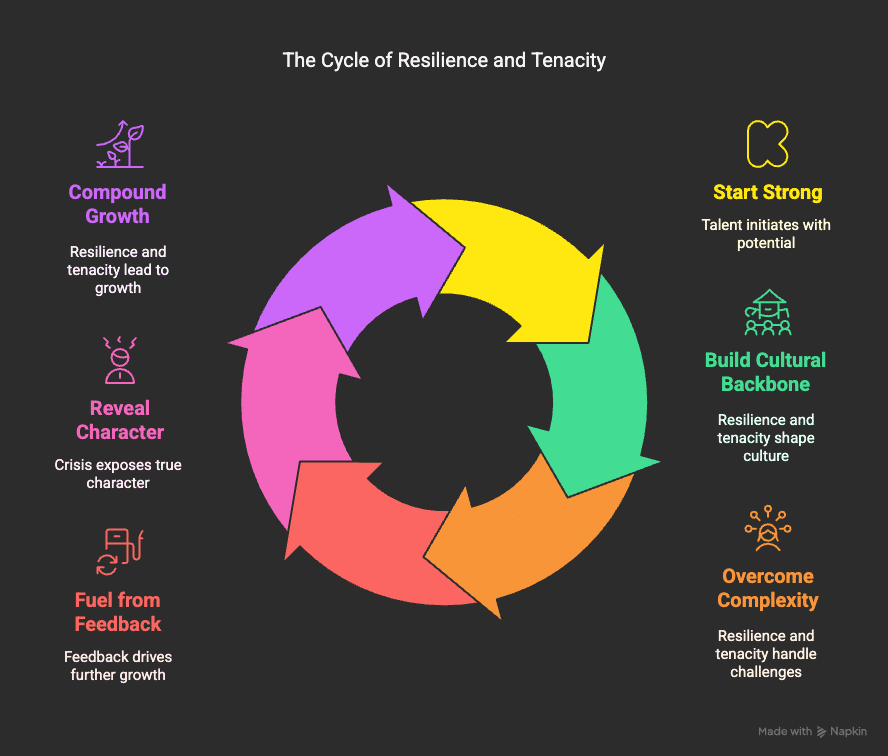Resilience and tenacity are often underestimated in boardrooms focused on hiring for pedigree and performance. But behind every enduring leader and high-performing team is one quiet truth: it’s not just about raw talent. It’s about who keeps going when things get hard.
At Champion PSI, we’ve coached CEOs who’ve built million-dollar companies not because they were the smartest in the room, but because they refused to quit. They stayed the course. They bounced back. They held the line when others folded. That’s the compound interest of executive coaching fuels success — and it wins over talent, every time.
This blog outlines six reasons why resilience and tenacity matter more than talent — and why these traits are your greatest assets when building leaders, cultures, and companies that last.
If you’re ready to go deeper on this topic, start here: Executive Coaching Services and explore how coaching and mentoring programs enhance leadership resilience.
Overview: What You’ll Learn
In this blog, we’ll explore six key reasons why resilience and tenacity beat talent in high-stakes leadership environments:
- Talent can start strong, but resilience and tenacity finish
- Resilience and tenacity build cultural backbone
- Talent doesn’t withstand long-term complexity
- Resilience and tenacity turn feedback into fuel
- Crisis reveals character, and talent can’t hide
- Resilience and tenacity compound, but talent plateaus
Let’s unpack each.

1. Talent Can Start Strong, but Resilience and Tenacity Finish
Some people launch fast. They ace interviews. They impress early. But leadership isn’t a sprint. It’s a thousand-mile marathon across unpredictable terrain.
Talent may give a head start, but without resilience and tenacity, it burns out when conditions get rough. And they will. Reorgs. Market crashes. Internal conflict. Personal fatigue. These aren’t exceptions — they’re the terrain.
We’ve coached leaders who had all the talent in the world but crumbled under pressure. Meanwhile, others who were overlooked early but had iron in their soul slowly rose to the top. Because they kept showing up. Because they didn’t flinch.
Resilience and tenacity are what finishers are made of.
2. Resilience and Tenacity Build Cultural Backbone
The tone of a company is set at the top. If the leadership team doesn’t demonstrate composure, courage, and commitment when things get uncomfortable, the culture absorbs that fragility.
But when leaders consistently model resilience and tenacity, they infuse the organization with those values. Employees don’t just hear about accountability, they see it. They watch how leaders respond to setbacks, and it shapes how they respond, too.
Cultural backbone isn’t built with slogans or quarterly themes. It’s built when leaders get knocked down and get back up without drama. It’s built when decisions are made in service of the long game, not the quarterly optics.
That’s how you create effective leadership development that lasts.
3. Talent Doesn’t Withstand Long-Term Complexity
Businesses today face a unique kind of complexity: constant change, hybrid teams, evolving customer expectations, and economic unpredictability. Talent alone doesn’t solve these challenges — especially when conditions shift fast.
Leaders with resilience and tenacity are better equipped to handle ambiguity. They don’t panic when there isn’t a perfect plan. They stay present. They assess. They adapt. That’s the quiet advantage they hold. This ability to pause and choose instead of react aligns with the key actions the best CEOs are taking right now.
These traits also prevent overcorrection. Leaders who panic under pressure often make drastic decisions, hoping to prove decisiveness. But those with resilience and tenacity hold space for uncertainty without rushing into reactivity.
This is often the tipping point for CEOs who need to engage in executive coaching for CEOs before reactive habits harden into leadership liabilities.
4. Resilience and Tenacity Turn Feedback into Fuel
Resilience and tenacity change how feedback lands. Where some leaders get defensive, gritty ones get curious. Where some spiral, they recalibrate. Where some hide, they lean in. This behavior shift drives what Forbes calls the leadership levers that drive performance.
Why? Because resilient leaders don’t see feedback as a threat to their identity. They see it as information — raw material to grow with. They understand that the best growth doesn’t come from applause. It comes from pressure.
This is especially important in executive environments, where unfiltered feedback is rare. Leaders who are tenacious and resilient can handle truth without ego — a trait we see in the top executive coaches working with high-performing teams.
And when that becomes normalized, it creates a culture where candor thrives.
5. Crisis Reveals Character, and Talent Can’t Hide
Anyone can lead in calm waters. But storms strip away the surface. They expose what leaders are really made of.
We’ve seen this play out during major organizational pivots, public failures, and executive transitions. The talented-but-fragile often retreat. They avoid tough conversations, delay action, or place blame. The resilient and tenacious? They step into the fire. Calmly. Clearly. Courageously.
And it’s not just about managing a moment — it’s about modeling character. When employees watch leaders lead with resilience and tenacity during hardship, it builds trust faster than any pep talk ever could.
This is leadership in its purest form: showing up when it matters most.
6. Resilience and Tenacity Compound, but Talent Plateaus
Here’s the most overlooked advantage of resilience and tenacity: they grow over time. Every time a leader faces adversity, processes it, and bounces back, they get stronger. They build psychological callouses. Not hardness — but readiness. Gallup calls this blend of self-awareness and growth what makes a great leader.
Talent, by contrast, has a ceiling. At a certain point, it stops being the differentiator. But resilience and tenacity? They keep stacking. They turn experience into wisdom. Pressure into discernment. Struggle into stature.
This is what makes them unstoppable. Not invincible, but unshakable. The kind of leaders people want to follow, because they’re grounded, clear, and committed — not just gifted.
That’s the real game.
Real-World Example: Johnson & Johnson’s Resilient Response
In 1982, Johnson & Johnson faced a nightmare: cyanide-laced Tylenol capsules led to several deaths. The company didn’t hide. It responded with speed, transparency, and decisive action — pulling 31 million bottles, pausing operations, and completely redesigning safety packaging.
This wasn’t just a legal or PR maneuver. It was an act of organizational resilience and tenacity. And it paid off: J&J regained public trust, reset industry standards, and turned a crisis into a masterclass in leadership.
Read the full Time Magazine article for a deeper look.
FAQ: Resilience and Tenacity in Leadership
What is the difference between resilience and tenacity?
Resilience is about bouncing back after difficulty. Tenacity is about pressing forward no matter how difficult. Together, they create leaders who are both adaptive and relentless.
Why do resilience and tenacity matter more than talent?
Because talent can crumble under pressure. Resilience and tenacity ensure leaders stay grounded, focused, and functional through difficulty.
Can resilience and tenacity be developed?
Yes. Coaching, reflection, and adversity can all help leaders build these traits. Like muscles, they strengthen through use.
How do resilience and tenacity affect culture?
They model composure under pressure, foster trust, and create a climate where challenge is normalized — not feared.
Can executive coaching help develop these traits?
Absolutely. Executive coaching provides a safe but challenging space for leaders to confront limiting patterns and grow their capacity for resilience and tenacity. For those looking to become an executive coach, this same inner work is non-negotiable.
6 Reasons Resilience and Tenacity Beat Talent: Conclusion
Resilience and tenacity don’t get headlines — but they build legacies. They’re the difference between fleeting talent and lasting leadership. The best CEOs we’ve worked with didn’t rise because things were easy. They rose because they refused to break when things were hard.
And they built cultures that did the same.
Ready to get started? Book a free 30-minute call with an expert coach to explore how resilience and tenacity can support your goals.










